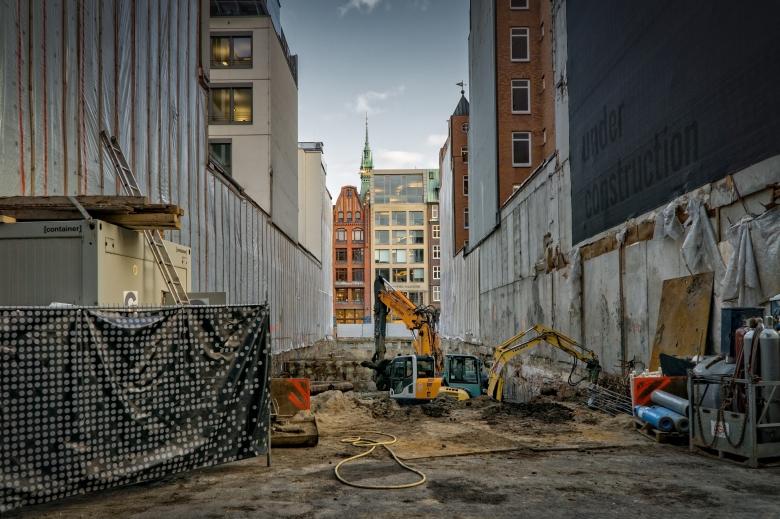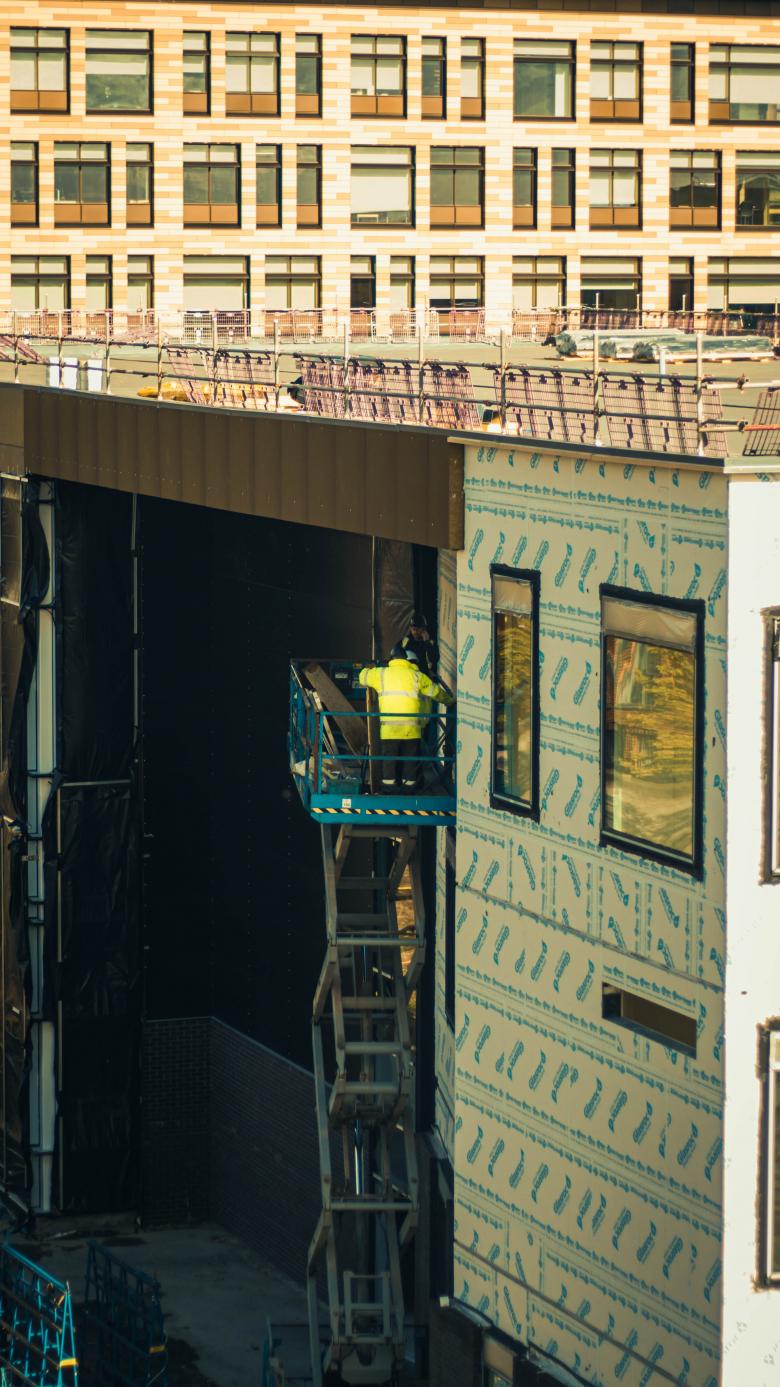Promoting Climate Protection in the Building Sector
Katinka Corts
30. November 2022
Photo: mali maeder
Circular construction — the avoidance of new material and the reuse of existing materials and components and their recycling — should be the order of the day. The WWF has conducted research on this topic and had its results examined in a brief legal study to see how realistic the implementation is. Many of the changes are feasible at federal and state level in the short to medium term.
"To people everywhere: I encourage you to double your efforts in this new decade and in this new phase." — Said Patricia Espinosa Cantellano, UNFCCC Executive Secretary, back in May 2022. A few months later, the COP27 climate conference in Sharm El-Sheikh, where we heard new, startling figures on, among other things, "hottest years on record", sea levels rising twice as fast, and greenhouse gases in the atmosphere peaking, is history. The 1.5°C target already seems unattainable, but this makes it all the more important to tackle global warming and combat greenhouse gas emissions as a contributor to global warming.
The fact that the construction sector accounts for a large share of global CO₂ emissions is now common knowledge and does not need to be discussed here. The so-called Circular Economy Action Plan is intended to ensure, as part of the European Green Deal at the European level, that the built environment is comprehensively renovated in terms of energy efficiency and that building product regulations are revised. In detail, this involves increased use of recycled materials, digital building logbooks, life cycle analyses of buildings, targets for the use of demolition materials, and reduced soil sealing. Hearing the EU's demands, one inevitably asks: What is my country's position in this regard?
Photo: Aleksandr Neplokhov
Germany and climate protection in the building sectorIn the coalition agreement, the coalition government of SPD, FDP, and the Greens has formulated ambitious climate protection policy goals. The Federal Climate Protection Act stipulates that the entire building sector may only emit a maximum of 67 million tons of CO₂-equivalent per year in 2030. The industry failed to achieve the planned gradual reduction already in 2020 (by 2 million tons) and also in 2021 (emissions development UBA). Land consumption, i.e. the designation of new settlement and transport areas, averages 54 ha per day across Germany and should have actually been 30 ha per day in 2020. And last but not least, the concrete goal of recycling materials in the construction industry has been watered down: Far too many materials are not reused to equal or higher value, but end up shredded as landfill and filling material — in other words, they are downcycled.
About 90% reuse rate of mineral waste seems high at first glance, but it is "not true recycling, but so-called downcycling, i.e. recycling with a lower performance spectrum compared to the source material."Promoting circular construction
In its background paper "Circular Economy in the Building Sector", WWF proposes various scenarios and policy measures on how to maintain and refurbish existing buildings and design new buildings to be suited to circular economy from the outset. It advocates promoting reuse at all levels of the building sector and using public buildings as a key lever. The WWF had its own demands reviewed by the Institut für Klimaschutz, Energie und Mobilität e. V. (IKEM, Institute for Climate Protection, Energy and Mobility) in a brief legal study. The energy experts and lawyers came to the conclusion that many ideas could be implemented at both federal and state level or could be included in the Model Building Code (Musterbauordnung [MBO]), which many state building codes follow.
The consumption of grey energy, which is still high today, has a particularly negative impact on the carbon footprint. Although energy standards in the building sector are rising and renewable energy sources are being expanded, the share of grey energy is increasing in terms of percentage — according to the WWF, it is an ideal lever, but it is not included in the current Building Energy Act (GEG). Life cycle analyses and life cycle assessments make is possible to view and evaluate buildings as systems. With such information, it would be easier to make informed and sustainable decisions. Recording via BIM is also a great help here, because the building passport, as the digital twin of the building, would retain data on the building's construction as well as its energy and building physical properties. Anchored in law and required throughout Germany, this would result in a large and valuable source of material for urban mining. The traffic light coalition (SPD, FDP, The Greens) has already taken a first step in this direction, as a digital building resource passport has been announced and initial approaches to its implementation have already been made. Critics often attribute higher costs to a recyclable building, and this is still the case when referring to the initial construction. But using durable materials in recyclable buildings pays off over the life cycle of the building. Mandatory circular procurement could even become compulsory for public construction projects. Wherever possible, preference should then be given to durable and recyclable materials that later lead to less polluting waste.
Photo: John Escudero
Prioritization of building preservation does not curtail basic rightsIt is nothing new that it often makes sense not to demolish buildings but to renovate and repurpose them. In the MBO, however, the demolition of existing buildings that are not listed is exempt from approval and only subject to notification. What is interesting about the compilation is that the brief legal study examines the list of measures from a legal perspective to see what laws would need to be changed at the federal, state, or local level to implement the proposed changes. According to IKEM, the proposed prioritization of building preservation does not infringe on basic rights because the proposed measure relates to public, not private, building projects. The municipality retains its scope of discretion in planning and organizing projects once the building project has been assessed and potential demolition has been justified. The authors see the federal legislature as responsible for this in the context of land law, air pollution control and waste management — the term air pollution control also includes protection against air pollution, which includes greenhouse gas emissions. The initiators hope that the introduction of a mandatory demolition permit will help preserve existing buildings that can be renovated and save CO₂ emissions caused by demolition and new construction. The WWF also proposes that deconstruction concepts should be made mandatory during the approval phase to ensure better recycling of the building products used. Since the federal states have sovereignty over building regulations, an amendment to the MBO could also change the respective building regulations of the federal states in both cases.
This is not a full discussion of the compilation of proposals; the WWF has also compiled ideas on the use of wood, the commitment to sustainable energy production, and other legal adjustments. WWF's background paper and IKEM's legal review of the measures are available online.
The German government needs to establish further mandatory measures to ensure that the construction sector meets its reduction targets, and perhaps even much lower CO₂ emissions levels after 2030. After all, as the passage on mandatory use of solar energy in the IKEM report states, "Financial incentives can be considered as a mitigating instrument, but these are not equally effective relative to mandatory use of solar energy, because they are always based on voluntariness." Or, to conclude in the words of Patricia Espinosa Cantellano, "We still have a long way to go."
________________________________________
WWF-Hintergrundpapier “Circular Economy im Gebäudesektor”
(WWF Background Paper “Circular Economy in the Building Sector”; in German only)
IKEM (2022): Rechtliche Prüfung von Maßnahmen im Bereich Gebäude und Kreislaufwirtschaft. Juristische Kurzstudie im Auftrag des WWF Deutschland
(IKEM [2022]: Legal assessment of measures in the field of buildings and circular economy. Brief legal study commissioned by WWF Germany; in German only)
Nutzungskonflikte in der Raumplanung / Conflicts of use in land-use planning
“Raumplanung sichtbar gemacht”
("Land-use planning made visible"; in German only)
Adapt the existing buildings, don't wait for the city of the future
“The City of the future has been built!”
Circular economy in the building industry
Interview with Margit Sichrovsky and Kim Le Roux
Abriss-Moratorium Demolition moratorium
“Offener Brief: Abriss und Neubau neu regeln!”
("Open letter: Re-regulate demolition and new construction!"; in German only)


